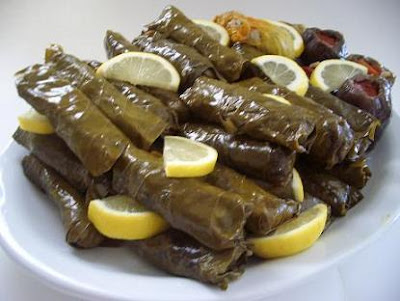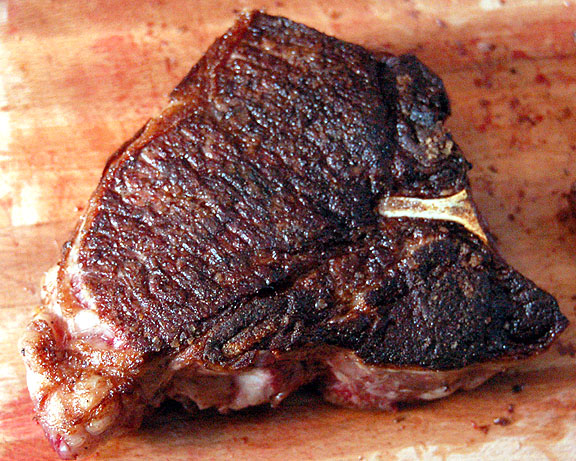Best Stuffed Grape Vine Leaves Recipe
If you search the Internet you will find several recipes for Stuffed Grape Vine Leaves.
Some vegetarian, with a rice filling; or with a
mixture of rice and ground beef or lamb. They also vary on rice cooking instructions, other mix-ins, and amount of filling per leaf roll up. There are some, just wrong in the instructions to fully cook
the rice. You want to par boil the rice so it can cook to doneness when you
poach the finished rolled up packages. People talk in terms of tablespoonful or teaspoonfuls of stuffing. The amount varies according to the size of the leaf. And, one person's teaspoon is another's tablespoon. Clearly, the map is not the territory.
Stuffed vine leaves and cabbage leaves have a wide ranging heritage. Of course, the Middle-Eastern countries. But, Mama Wronski of Polish descent would regularly please the family with her delicious meat and rice filled cabbage rolls; Gołąbki [ɡoˈwompki . . . that "ł" in Polish is pronounced as an English "w"]. Grape leaf roll ups are also a part of the Eastern European and Russian cuisines.
Stuffed vine leaves and cabbage leaves have a wide ranging heritage. Of course, the Middle-Eastern countries. But, Mama Wronski of Polish descent would regularly please the family with her delicious meat and rice filled cabbage rolls; Gołąbki [ɡoˈwompki . . . that "ł" in Polish is pronounced as an English "w"]. Grape leaf roll ups are also a part of the Eastern European and Russian cuisines.
Here is a meatless version with an ingredients mix
combined from a few recipes. The best of everything. Add ground beef or lamb and adjust the amount of rice accordingly.
Stuffed Grape Vine Leaves Recipe: Makes approximately 40 small packages
Grape Vine Leaves / Cabbage Leaves (alternative)
Unless
you have your own grapes growing* you will have to buy them packaged. They come
about 100 to a jar or plastic pouch and will have to be soaked briefly in very
hot water to remove the brining salt.
*If you are lucky enough to have fresh vine leaves, just blanch them before using.
The
next step to get the leaves ready is to snip off the tough stems.
Cabbage
leaves are also an option, just to soften them in boiling water a bit to get
them to roll up around the filling without cracking. And to trim off any thick spines.
For the Filling:
— One Cup Long Grain or Basmati white rice
Parboil
by adding to 1 cup boiling water, adjust heat to low and let cook covered 5
minutes. Drain and let cool.
Brown
rice will work, but lengthen the par boil to 10 minutes.
— 1/2 Cup finely chopped Onion
Sauté chopped onions in olive oil or butter until translucent
— 3 T toasted Pine Nuts, toast in dry skillet tossing until nicely browned.
— 3 T currants (previously soaked)
— ½ Cup finely chopped fresh Dill
— ½ Cup finely chopped fresh Parsley
— ¼ Cup finely chopped fresh Mint
Dried
herbs will do in a pinch, but use sparingly. Think 1 part dried = 4 parts
fresh.
— 3 T Olive Oil
— 2 T Fresh Lemon Juice
— 2 T Fresh Lemon Juice
— Salt and pepper to taste
Stir
carefully to combine ingredients.
Rolling the filling into the leaves: (Here's a good picture tutorial)
Place a large vine leaf on a flat surface shiny side down, ribbed side up. Large (stem) base toward you.
Place
a tablespoon of the filling in the middle at the broad base. Some recipes call
for only a teaspoon of filling. Adjust the amount to proportion with the leaf
size. Also, to your preference for size of the finished roll up.
First
fold wide part of leaf toward the center onto filling, roll, and continue to
fold sides toward the center until package is finished. If you have a broken or
smallish leaf, put two together.
Roll
the vine leaves snug but not tight, nor loose. The poaching to finish will cause
the rice to expand a bit to result in a nice firm package. Practice makes
perfect.
Place
flap side down in a medium pan with vine leaves lining the bottom (2-3 layers
thick), arranging packages neatly and snugly, but not tight. Remember they
expand. Some packages may split open in the cooking . Not a problem. They taste
the same, just not as pretty as they should be.
Cooking the Vine Leaf Packages:
You will see that in your store package of vine leaves some are small and others are large. Use the large to make the roll ups. The smaller leaves can be used to thoroughly line the bottom of a medium sized pan.
— Water to cover. Chicken broth instead of water is
optional.
After
all your roll ups are arranged in the bottom of the pot, add water just to cover
and press a heat proof plate on top.
— Addition 2T Fresh Lemon Juice to the poaching liquid.
Bring
to boil, lower heat to simmer, poach for approximately 20-30 minutes until done
and tender.
Serving:
Let
cool to set. Serve hot, room temperature or cold with lemon slices to garnish, mint-
yogurt sauce on the side (optional).
Add
to a pita pocket sandwich with chopped vegetables and dressing.
Here is an instructional video showing A to Z. The demonstration is for a meat version. All rice version, remember to par boil and roll snug (not tight) to allow for expansion of the rice. (We told you there were many versions out there.)
If you have to get all "Martha" [Stewart] about it, get a gadget . . . (It may be Turkish to you, but a picture is worth a thousand words.)













